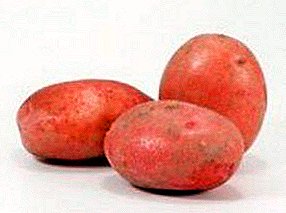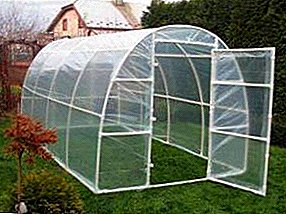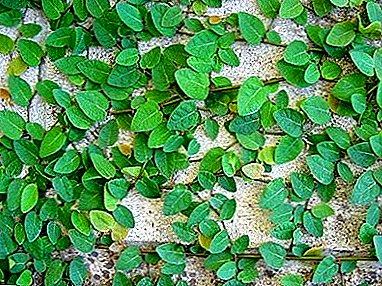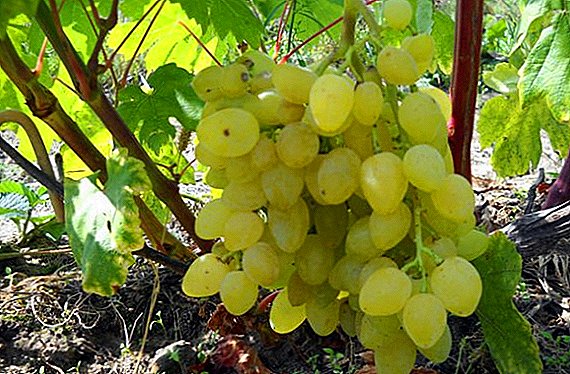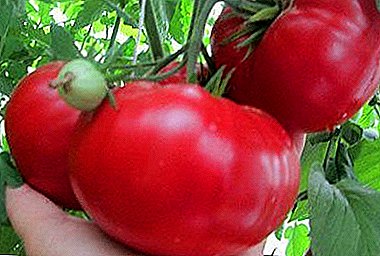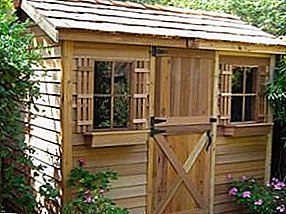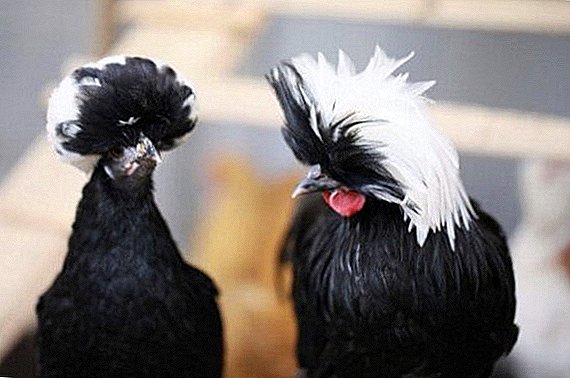 Dutch white-cooled chickens are attractive not only for their decorative appearance, but also for their productivity. Many farmers note the high egg production of layers of this breed and decent quality of meat. What are the features and disadvantages of such a bird, what are its requirements for conditions of detention - we will tell about it later in the article.
Dutch white-cooled chickens are attractive not only for their decorative appearance, but also for their productivity. Many farmers note the high egg production of layers of this breed and decent quality of meat. What are the features and disadvantages of such a bird, what are its requirements for conditions of detention - we will tell about it later in the article.
Origin
The current appearance of black chickens with a bluish glow of a feather and a unique white tuft on the head is so ingrained in the minds of the poultry farmers that it is difficult to imagine it as something else. And in fact, at the beginning of its inception, this breed was recognizable only by its black or dark brown plumage with rare red specks. The first mention of it dates back to the XV century. Then the Dutch breeders placed the main emphasis on the productivity of domestic animals. Therefore, the presence of a lush "hair" on chicken heads could not be considered.
Did you know? In the ranking of the most amazing chicken breeds, primitive representatives of the Indonesian Ayam Cemani received primacy. They are distinguished by completely black plumage, claws, skin and crest. Even the meat and internal organs of the original birds are also black. By the way, this color does not fade after heat treatment. Many believe that black birds bring their owner eternal success, so they are willing to pay $ 5,000 for a couple.
Ancient ancestors of the modern Dutch white-crested completely corresponded to the mission entrusted to them. For many years they have been a reliable source of meat and egg products. But soon the breeders decided to improve their charges, instilling in them non-standard external features.  Now they were faced with the task of drastically changing the appearance of the chickens, while retaining their egg production and meat qualities. For further crossing, samples of the Polish Crested Breed were selected. According to experimenters, the resulting brood was supposed to distinguish the breed with its beauty and productivity. But the hopes pinned were a fiasco: the young generation possessed vivid signs of the exterior and did not at all please the breeders with the number of eggs, as well as the quality of the meat.
Now they were faced with the task of drastically changing the appearance of the chickens, while retaining their egg production and meat qualities. For further crossing, samples of the Polish Crested Breed were selected. According to experimenters, the resulting brood was supposed to distinguish the breed with its beauty and productivity. But the hopes pinned were a fiasco: the young generation possessed vivid signs of the exterior and did not at all please the breeders with the number of eggs, as well as the quality of the meat.
Did you know? The most delicious chicken in the world is the French Bress Gali breed (La Bresse Gauloise). She is known for the fact that since 1957 she has been the only owner of the AOC quality mark. For the sake of this bird, every year in the country they organize a magnificent chicken show, where farmers have the opportunity to compete for the best carcass. Winning this competition is very prestigious. In addition, each manufacturer is encouraged by a cash prize of 10 thousand euros.
If you compare the former and the current representatives of the breed, the decline in productivity is obvious. However, this did not prevent the Dutch hens to become favorites for many breeders. Some bought cute birds to please the eyes, others to provide their family with their products. In addition, the history included the facts when the white-crested layers were revered as a symbol of prosperity, because only the wealthy owners decorated the yards. In addition, many artists captured unusual poultry on their canvases. 
External characteristics
Modern white-skinned Dutch breed qualifies as a decorative type of chickens. Its unique appearance is not difficult to recognize by many signs, the most striking of which is the luxuriant black and white tuft. Let us consider the characteristics of the exterior.
Read about the best egg and ornamental breeds of chickens.
Color
As a rule, thoroughbred roosters and layers have pure black thick plumage. It covers the entire body completely, getting to the very white tuft. Long hanging feathers wedged into it, which gives the bird a special attraction. The front feathers gently fall on both sides of the chicken head, creating the impression of professional styling. Moreover, they are in tandem with this voluminous "hairstyle" create a specific pattern, forming at the base of the beak something like a butterfly. It is on this basis that it is customary to determine the purity of the breed.  In addition to the traditional pure black Dutch white-and-white, in the world there are rare representatives of the blue and white colors. Note that such instances - a rarity.
In addition to the traditional pure black Dutch white-and-white, in the world there are rare representatives of the blue and white colors. Note that such instances - a rarity.
Important! If you ever meet these unique lines of the Dutch variety, please note: the breed standard categorically does not allow yellowing of the feather on the whites and ripples on the blue crested hens. The former are distinguished in pure white color, while the latter are close to steel-gray or bluish-slate shades.
Head
In females and males, this part is distinguished by its small size, prominent broad forehead, and smooth reddish profile. They have absolutely no bristles and comb.
But the brightest and recognizable characteristic of the head can be safely considered a spherical large crest. If the feather cap is small or differs from the standard in other forms, such a bird can no longer be considered pedigree. And, contrary to the general fallacy, the crest does not at all interfere with the review of chickens. Their small brown-red eyes are clearly visible from under the feathers.  On the head barely noticeable small "earrings", characterized by large size in roosters. The bill is characterized by the same shape as other relatives, and its color exactly corresponds to the tone of the main plumage. Ear lobes are small and white.
On the head barely noticeable small "earrings", characterized by large size in roosters. The bill is characterized by the same shape as other relatives, and its color exactly corresponds to the tone of the main plumage. Ear lobes are small and white.
You will probably be interested to learn about other representatives of crested breeds of chickens.
Torso
Crested "Dutch" are also recognizable thanks to the compact size of their bodies. They are characterized by a well-developed belly and a slightly retracted body. Therefore, the breast has a small protrusion. From a distance, the body of such a bird resembles a trapezoid shape with a dense feather. Layers weigh about 1.7-2 kilograms, and roosters weigh no more than 2.5 kilograms.
The hens have thin legs and gray-black legs of medium size. Special attention should be paid to the tail, which can rightly also be considered a decoration of the breed. It is characterized by slightly flattened fluffy feathers, high supply, as well as grace.
Did you know? Habitually perceived as compact poultry. And few people know that among them there are real giants. One of these is the Australian variety of Uightsulli. Her representatives weigh about 10 kilograms and differ chest girth 60-70 cm.
Nature of chickens
In addition to attractive external characteristics, Dutch birds have a specific character. Very rarely in the courtyard you can see a representative of this breed calmly resting.  And all because they are characterized by the following features:
And all because they are characterized by the following features:
- constant haste and ubiquitous bustle;
- excessive activity and swarming;
- increased fearfulness as well as sensitivity;
- painful perception of the change of familiar surroundings and owner;
- friendliness towards other residents of the yard;
- pack cohesion;
- moderate aggression of cocks towards strangers threatening the harem.
Productivity
Despite the fact that the current performance indicators of the breed have declined significantly compared to the original, experts believe the Dutch crested hens are worthy competitors to other meat-and-egg relatives. Here are the arguments explaining this position:
| Dutch Crested productivity | ||
| Live bird weight | Annual egg production | Egg weight |
| Females: 1.7-2 kg; Males: up to 2.5 kg. | 140 pieces - the first year; 100 pieces - in the future. | 40-50 g |
 You can not settle the Dutch white-cooled chickens with other breeds. This is due to cross-infections, different resistance to diseases, as well as the specific appearance of decorative birds. The fact is that these creatures perfectly distinguish their dissimilarity in an artificially created pack, which can cause frequent conflicts.
You can not settle the Dutch white-cooled chickens with other breeds. This is due to cross-infections, different resistance to diseases, as well as the specific appearance of decorative birds. The fact is that these creatures perfectly distinguish their dissimilarity in an artificially created pack, which can cause frequent conflicts.Find out why chickens do not rush, how to increase the productivity of chickens in winter and what vitamins chickens need for laying eggs.
Feeding
In the care and maintenance of these birds were very difficult, so the poultry farmers from the very first days of the appearance of this animal in the farm should be prepared for difficulties. Particular attention should be paid to the chicken diet, because the Dutch white-crested are very sensitive digestive tract. Moreover, this feature applies to both the younger and mature generation.
For the organization of proper nutrition to feathered wards, experts recommend:
- Feed poultry with wet food at least 1 time per day.
- In a well-chosen diet of chickens, 70% of the total composition should fall on the grains, since they are the main source of nutrients. On this basis, mixtures of wheat, maize, barley, rye, oats, and legumes will be appropriate to support egg production.
- To feathered wards differed healthy and attractive appearance, as well as a strong immune system, it is desirable to add fats of animal and vegetable origin to the mash.
- In the daily diet of chickens about 30% of the total composition should be vegetables and roots. They can be given in raw, boiled form or as part of mash beans.
- Not superfluous will be fish oil, bone meal, flax seeds, chalk, fortified supplements. These components will improve the productivity of poultry in the case of standardized dosages in accordance with the instructions of the manufacturers.
- In the autumn-winter period for chickens and adult chickens are shown warm, but not hot feed with the addition of dry grass. In addition, portions need to be increased, and with the arrival of spring, the flock can be released on pasture.

Important! So that chickens do not have worms, veterinarians advise, for preventive purposes, every month for 3 days, wards of different ages should be watered with fresh decoction of chamomile and sorrel.
Maintenance and care
Wrong conditions for fanciful "Dutch" can play a cruel joke with all the livestock and drive the owner at a loss. Therefore, having decided to acquire an original bird, find out as much information as possible about its requirements.  The main rules in the content of this breed are:
The main rules in the content of this breed are:
- Lots of freedom and unlimited space. This means that the wards cannot fully develop in the cell. For them, the conditions of a closed territory are not acceptable. Ideally, in advance you need to take care of a spacious chicken coop and a huge aviary so that in the allotted area at least one square meter should fall on each individual. Comfortable and wide perches, drinking bowls, feeders and a kupalka remain mandatory attributes for the house.
Learn how to make bunker and automatic feeder for chickens, as well as a feeder from plastic sewer pipes with your own hands.
- Constant heat. The peculiarity of the breed lies in its intolerance to low temperatures. It is very sensitive to cold and frost. Therefore, for the comfort of feathered living creatures, you will need to equip a heating system in the hen house. It is important that in the cold season in a chicken house the temperature of the air should be within 15-20 degrees Celsius. Note that walks in the winter season of the Dutch white-crested are contraindicated. This is worth considering if you do not want in one moment to lose the entire flock.
- Daily cleaning and good ventilation of the room. This requirement in the maintenance of chickens due to their decorative qualities and a constant stay in the hen house throughout the cold season. It makes sense to ensure that in the house the optimum humidity is maintained at 55-70%.

Many owners of the crested "Dutch" tend to decorate the "hairstyle" of their wards. It seems to some that dangling feathers make it difficult for chickens to observe the surroundings. That is why there are cases when poultry farmers resort to shearing. According to experts, such methods are nothing more than unnecessary care. Do not interfere with natural processes. Chickens of this breed do not require grooming.
Did you know? The most tailed roosters on earth are representatives of the Chinese breed Fen-Huang (Onagadori). At one time they were symbols of the empire and the personification of wisdom. It is believed that these owners of ten-meter tails can bring good luck in the search for life truth and even treasure.
Advantages and disadvantages
Like any animal, the Dutch white-crested feathery in its characteristics have positive and negative qualities. Let's see what is more.
The advantages of the breed are:
- specific non-standard appearance with high decorative qualities;
- high egg production;
- satisfactory meat indicators.
 Its disadvantages include:
Its disadvantages include:
- badness of character;
- low immunity and tendency to various chicken diseases (frequent cases of massive mortality are recorded);
- demanding of living conditions and diet;
- low survival of the younger generation, even with all the rules and recommendations.
Beautiful, fastidious, and even with a bad temper - the Dutch white-and-white hens actually turned out to be such. Of course, being in your courtyard, they will give pleasure to the look. But how long it will last depends not only on you, but also on a number of genetic factors of the birds.
Video: Dutch white-chicken
Reviews






